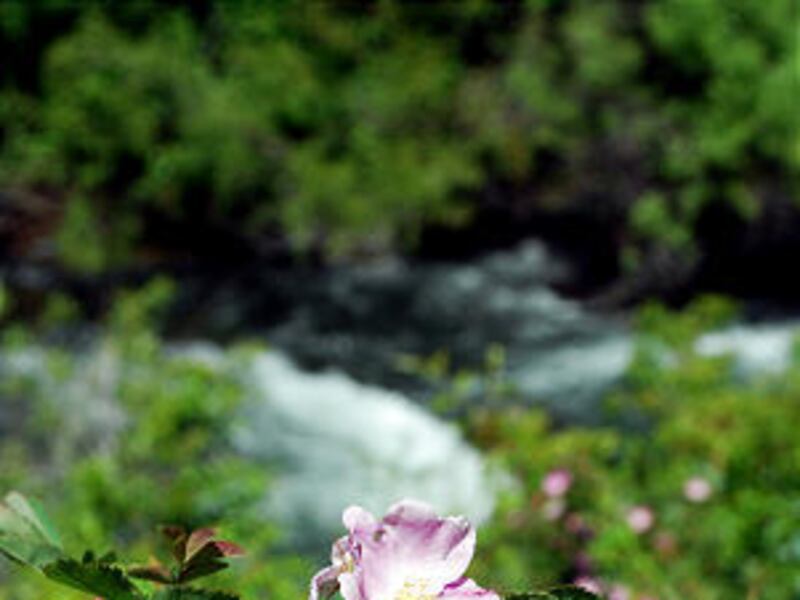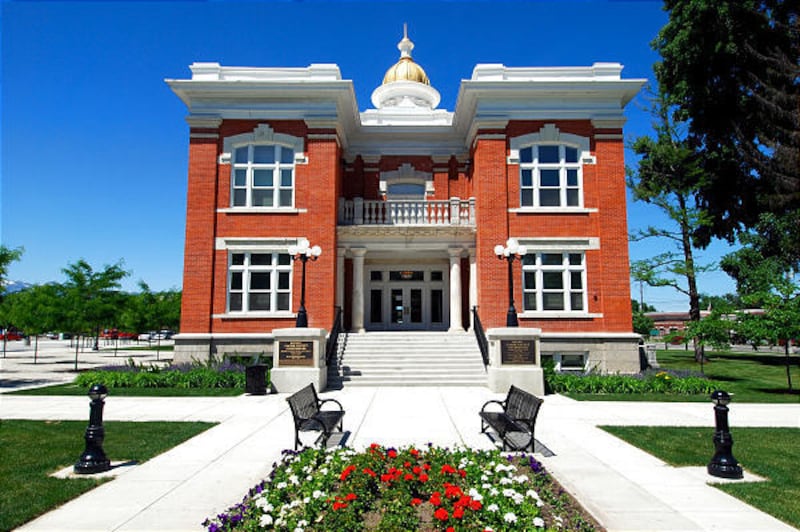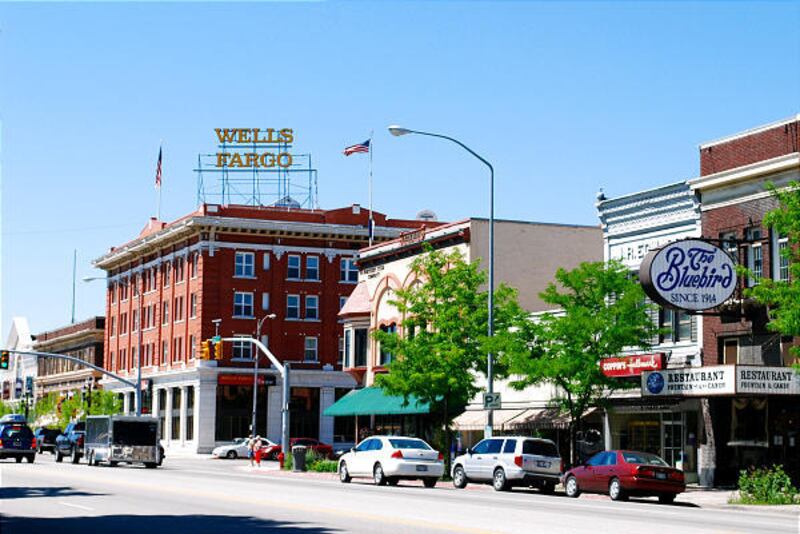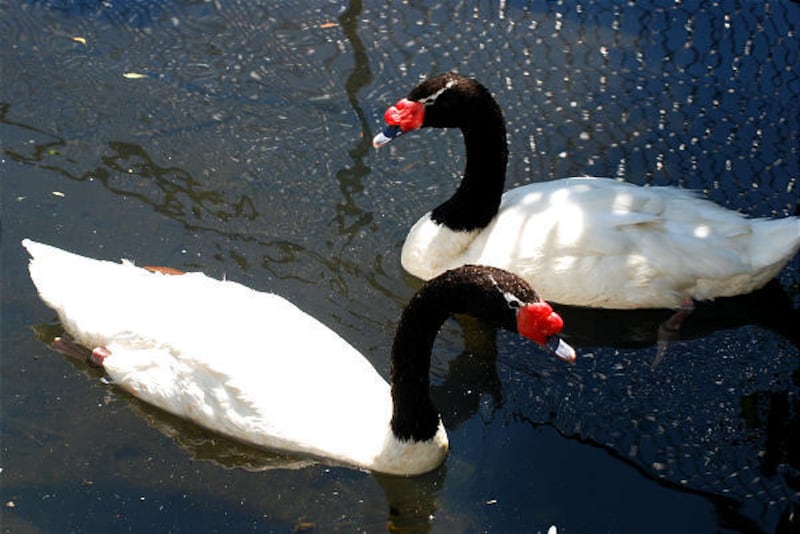LOGAN — For the past seven summers, Tom and Pat Lundregan of Chandler, Ariz., have been "sunbirds," spending a dozen pleasant weeks in and around Logan, their home away from home.
Unlike "snowbirds," who head south to escape winter, retired "sunbirds" like the Lundregans — he's originally from Illinois, while she hails from Oklahoma — live in the sunny Southwest most of the year and migrate north to escape the harsh midsummer desert heat.
"They've got it good up here," Lundregan notes during a stop with his wife for an update and a bit of souvenir-shopping at the Cache Valley Visitor Center, in the historic county courthouse downtown.
"Want to know what's going on? Stop here," says Ann Egland, working the welcome counter. "On any given day, there's lots of things going on."
And during summer, she says, "I think Logan shines."
Indeed, Logan is entering its tourist-magnet peak.
The marquee Utah Festival Opera season begins July 8 and continues through Aug. 8. Founded and headed by opera singer Michael Ballam, this year's lineup includes Gilbert and Sullivan's whimsical fantasy of old Japan, "The Mikado"; the Broadway favorite "Camelot"; George Bizet's "Carmen"; and the Italian classics "Cavalleria Rusticana" and "I Pagliacci."
Already under way downtown is Old Lyric Repertory Company's theater season, with performances in Utah State University's Caine Lyric Theatre through Aug. 1. The rotating plays are Larry Shue's comedy "The Foreigner"; "You're a Good Man Charlie Brown," the musical based on Charles Schulz's "Peanuts" characters; Oscar Wilde's witty "The Importance of Being Earnest"; and the more recent mystery "Ghosts of Ocean House."
And Cache Valley's venerable Festival of the American West has evolved to a year-round venue, the American West Heritage Center, just off U.S. 89-91 in Wellsville, southwest of Logan. Besides the longtime exhibits at the 1917 Jensen Historical Farm, the site now includes a new museum, a "pioneer settlement," a mountain man "fur trade encampment" and an area dedicated to the region's native Shoshone Nation. The "Spirit of '47 Pioneer Jubilee" will celebrate Pioneer Day on July 24.
And those are just the headliners.
Options galore
The courthouse tourism office has shelves and shelves of brochures and ideas for those looking to supplement the festivals with other activities, including a Cache Valley arts calendar; a self-guided tour of birding trails, a hiking trail guide for the Logan Ranger District — and of course the Cache Valley food tour.
How can one drive through this productive valley and not consider stopping at the Pepperidge Farm bakery outlet store on U.S. 91 in Richmond to pick up some cookies or Goldfish, those tiny crackers, available here in bountiful plastic bags?
How about specialty ice cream (and perhaps a yummy sandwich) at Utah State University's campus Aggie Ice Cream shop, or fresh cheese (curds anyone?) or ice cream at Gossner Foods at 1000 W. 1000 North?
Or "harvesting" a few sweet honey bottles at Cox Honeyland on U.S. 89-91, between Wellsville and Logan? Or chocolates at the Bluebird Candy Co. (and cafe) downtown?
But the guide also points visitors to vendors who make and sell artisan bread (Crumb Brothers), micro-dairy cheese (the Rockhill Creamery farmstead, a few blocks east of U.S. 91 on State Street in Richmond), and the jams and juices from another working farm (Weeks Berries of Paradise — in Paradise, of course).
And as anyone who has motored through Cache Valley can tell you, green pastoral scenes and history are everywhere. Why, wandering the valley to see calendar-worthy barns isn't a bad pastime. (The area has at least two century-old barns advertising in huge white lettering "Dr. Pierce's tonic" for women.)
Several blocks of downtown Logan itself are considered a bona fide historic district, listed on the National Registry of Historic Places.
"Logan displays a not unpleasant mixture of the new and old, having retained much of the charm of the venerable and distinguished age," Ward J. Roylance wrote in his 1982 revision of the Depression-era WPA book "Utah: A Guide to the State."
Drive through Logan's central residential areas and you're likely to see homey examples of just that: Lovely houses that could have been the inspiration for a little girl's dollhouse, circa 1920; or one with craggy tan stones and pastel flowers that looks like it could have been transported directly from rural England.
Downtown has its own self-guided walking tour brochure — or you could join Ann Egland at 10:30 a.m. each Monday, Wednesday and Friday for her take on the area's past, complete with anecdotes..
"It gives people an idea of what it was like here in the 1880s," she says of both the guided and self-guided tours.
The courthouse itself, built in 1883 and renovated in 2005, is a fine example of Logan Past.
Egland shows off the antique, scenery-painted (but empty) Moser safe in the center hallway; large-scale paintings on the walls by Utahns Minerva Teichert, Everett Thorpe and Kent Wallis; the elegant board room, with specially milled and tinted carpet, where the Cache County Board still meets ("this is the oldest government building still in use" — as a government building — "in Utah," she says).
And just outside is the spot where a man was lynched in 1873, only days after he killed the proprietor of a nearby shop on Valentine's Day, she says. A different courthouse was on this spot then.
"Startling as it may seem," adds the tour pamphlet written by Gary N. Anderson, "Logan was part of the Wild West where vigilantes, ruffians, cattle rustlers and stagecoach robbers were part of everyday life."
Other structures of note line Main and Center streets: the Cache Chamber of Commerce is in the old Federal Building, and there are banks and railroad offices and theaters more than a century old.
One of the most striking buildings on Main Street is the LDS Tabernacle, which is open for tours most days — and is sponsoring a series of noon concerts all summer, featuring everything from instrumental soloists and glee clubs to performers of the Utah Festival Opera Company (the latter on most Mondays).
Logan residents Don and Jean Sisson were working as volunteer guides on a recent day, and they added a personal touch when telling the tabernacle's story.
He, for instance is an LDS convert and was baptized in the tiled baptismal font on the tabernacle's lower level.
Sisson said completing the tabernacle proved to be quite a long-term task for the city's pioneering settlers. Construction began in 1864 — but wasn't completed until 1891.
"It took so long because of the railroad (the transcontinental railroad came through Utah in 1869, and the Utah Northern Railroad spur to Logan soon followed), the temple, Indian problems and several leaders were called on missions," he said.
The stately, castellated Logan LDS Temple, built of rough-hewn gray limestone quarried from the mountains nearby, presides over Logan from a terrace to the east, visible from the tabernacle grounds, Sisson pointed out.
"And I just learned that it was originally painted white," as its contemporary in St. George still is, Jean Sisson said.
Another option, for those interested in contemporary art, is also just up the hill. The Nora Eccles Harrison Museum of Art on the USU campus has a truly diverse collection, currently exploring "what each artist's idea of reality might be," as its guide says … Many will find reality can mean "surreality," for the swirling ceramics and abstract canvases are wonderfully colorful — and sometimes musical.
For instance, "Klompen," by the artist Trimpin, is a coin-fed "sound sculpture" consisting of 96 dangling Dutch wooden clog shoes that are computerized to produce a percussive melody.
You don't see — or hear — that every day.
Room to roam
Although history is everywhere evident, that does not mean Cache County has not seen change and growth. Logan and its neighbors, from Paradise and Avon on the south to Cornish and Cove to the north, have seen their share of newcomers in the past few decades. According to the U.S. Census, the county's population doubled between 1980 and the 2008 estimates, from 57,176 residents to 112,616.
But there remains plenty of room to roam — or golf, or bicycle, or hike or motor through on a pastoral scenic drive.
As if the city's tree-lined sidewalks and the county's rural roads were not enough, also handy are several urban, or semi-urban, trails.
Among these are the Logan River Walk, through the Logan River Golf Course; a segment of the Lake Bonneville Shoreline Trail; and the Logan River Nature Trail, from near the mouth of Logan Canyon to Guinivah amphitheater, the latter a 5-mile trek if you want to do the entire route, one way.
North Logan's Kayleen Skinlo escorted her three children — year-old Kai; 4-year-old Sienna; Jackson, 8, and his friend Alex — along the third-of-a-mile walk along the Logan River to the Stokes Nature Center on a recent weekday afternoon.
"We just went out for a little walk," she said inside the kid-friendly learning center. "We walk here, and I enjoy that," because it gets them all out and about.
The children checked out the nature and photo displays, ogled a few animal skulls, including those of a beaver, a moose and an elk ("Look at that! That's big," Skinlo said to them). Nearby were small live creatures, including a salamander and a tarantula.
Logan has several such options for families, she said. Nearby Green Canyon is easy enough for the children to ride their bicycles. They all enjoy walking through Logan's Willow Park Zoo, which has great numbers of birds, from colorful macaws to regal eagles. And the zoo is a deal: a suggested $1 donation for adults, 50 cents for kids.
And then there's Logan Canyon itself. The Skinlos — adults and children — have all hiked the 2 miles up to the arch-like Wind Caves (aka, the Witch's Castle), beside Tony Grove Lake and along other mountain trails. The tourism bureau's brochure describes 31 sites and stops to see on this stretch of U.S. 89, a designated National Scenic Byway.
Fishing is popular at First Dam, Second Dam and Third Dam, and along the river. And the canyon hosts several shady campgrounds and picnic spots. Tributary roads head off into Temple Fork and other canyons in Wasatch-Cache National Forest.
"To tour Logan Canyon is to step back into the spirit, if not the look and feel, of the Old West," Michael S. Sweeney, a journalism professor and head of the Department of Journalism and Communication at USU, wrote in "Last Unspoiled Place: Utah's Logan Canyon," published by the National Geographic Society. (The 2007 book also features a great many beautiful images by Utah photographer Scott T. Smith.)
On the other side of the range, U.S. 89 offers spectacular views of sky-blue Bear Lake, on the Utah-Idaho border. Below are Garden City, Laketown, a state park harbor … and even more loop-drive options, such as the route north into Idaho and back toward the upper Cache Valley via Emigration Canyon, or the Monte Cristo highway, which climbs to a high ridge before winding down to Huntsville and the Ogden Valley, south of Logan.
"Cache," Egland notes, "comes from the French word 'cacher,' " for trappers — and at least one blacksmith, hence Blacksmith Fork Canyon above Hyrum — "cached" their goods (or tools) for safe-keeping here during the early 1800s. They were secret treasures.
But it should be no secret that Utah's Logan, Cache Valley and their forested mountains offer anyone — day tourist, vacationer or multiweek "sunbird" — plenty of things to do and to see.
Logan offers summertime activities, charm Cache Valley Visitors Bureau: www.tourcachevalley.com (800-882-4433), County County Courthouse, 195 N. Main, Logan
Utah Festival Opera: www.ufoc.org (800-262-0074); box office: Dansante Building, 59 S. 100 West, Logan
Old Lyric Repertory Company: boxoffice.usu.edu/ (435-797-8022); Caine Lyric Theatre, 28 W. Center St., Logan
The American West Heritage Center: www.awhc.org (800-225-3378), 4025 S. Highway 89-91, Wellsville
Nora Eccles Harrison Museum of Art: www.usu.edu/artmuseum (435-797-0163), 650 N. 1100 East, Utah State UniversityFor more information
Cache Valley Visitors Bureau: www.tourcachevalley.com (800-882-4433), County County Courthouse, 195 N. Main, Logan
Utah Festival Opera: www.ufoc.org (800-262-0074); box office: Dansante Building, 59 S. 100 West, Logan
Old Lyric Repertory Company: boxoffice.usu.edu/ (435-797-8022); Caine Lyric Theatre, 28 W. Center St., Logan
The American West Heritage Center: www.awhc.org (800-225-3378), 4025 S. Highway 89-91, Wellsville
Nora Eccles Harrison Museum of Art: www.usu.edu/artmuseum (435-797-0163), 650 N. 1100 East, Utah State University
E-mail: features@desnews.com







